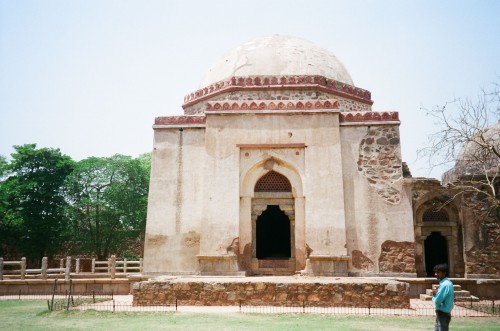
Firoz Shah's tomb is located in Hauz Khas (New Delhi), close to the tank built by Alauddin Khalji. Attached to the tomb is a madrasa built by Firoz Shah in 1352-53. The entrance to the tomb is through a courtyard. The archway of the entrance gate has a date engraved on it- 1507-08, the reign of Sikandar Lodi, which suggests that he may have had the tomb repaired. The tomb is square in plan, heavy and massive with plain cemented walls unlike the marble on the facade of the Ghiyas tomb, and a slightly pointed dome supported by an octagonal drum. The lower curves of the dome arches are decorated with intersecting colored bands. The arches contain Quranic inscriptions and the walls are decorated with floral designs. Firoz Shah's tomb differs from that of Ghiyas in the use of construction materials. Unlike the latter, it is not built of stone; instead a thick layer of durable stucco is used which was probably painted. It has a paved verandah, enclosed by Buddhist stone railings of the type found in Sanchi. It is not clear why these stone railings were used. One view is that Firoz Shah used these pre-Muslim Indian forms as a means of associating himself with earlier greatness. There are no inscriptions on the four graves inside the tomb. It is believed that the central grave is that of Firoz Shah, and the two similar ones are probably those of his son, Nasir ud din Mahmud, and grandson, Ala-ud-din Sikandar Shah.